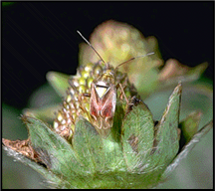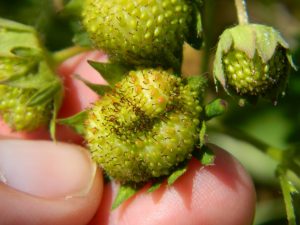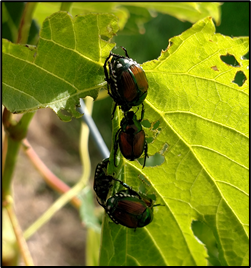Spring Insects in Berries: Tarnished Plant Bug and Japanese Beetle

Tarnished plant bugs (TPB) have been present at all of our sites in and around Dane county strawberry fields for the last week or so now and populations of nymphs and adults have been increasing. Plants are in the mixed stage of bloom and small fruits, and sampling for nymphs and adults should happen at least once a week. Both adults and nymphs will feed on strawberry plants and can cause damage. The action threshold for implementing chemical control is 4 adults per 20 sweeps or 1 nymph in 4 flower clusters. Insecticides include Brigade and Danitol for pyrethroids and Actara and Assail for neonicotinoids. Please refer to the Midwest Fruit Pest Management Guide for more insecticide recommendations. More info on TPB can also be found in this previous article.

There may be some questions at this time regarding whether a type of damage such as the one oberserved in Figure 2 comes from TPB feeding or from a frost event in the spring. Both can lead to fruit malformation and to the concentration of seeds on the affected portion of the fruit, making it hard to identify what the culprit may be. Annie Klodd from the University of Minnesota and I discussed the damage observed in figure 2 and came to the conclusion that this is likely due to spring frost. Annie summarized the reasoning nicely here: “This early variety did have a few blossoms already emerging during the mid-May frost, the grower had controlled well for TPB, and the injury was occurring on the king fruit rather than multiple berries per cluster.”
Taken from Annie Klodd’s nice article, here are some general tips to differientiate frost damage from TPB include:
- Most of the damage caused by TPB occurs at the tip of the berry due to the characteristic position of the TPB when feeding on small berries (Figure 1) while frost damage may appear on the exposed side of a berry or more randomly on a berry.
- TPB often feed on several fruits within a cluster whereas frost damage may affect only one fruit and in particular the king fruit which is the first flower to open in the spring and thus may be more exposed to freezing temperatures early in the season.
To insure the damage comes from TPB, it is important to scout as previously described here. If a management program for TPB has been put in place, then frost damage is more likely the cause for the observed damage.
- As Annie mentions in her article: “Consider the bud stage of the plants during the last freeze/frost event. The more developed the blossoms were, the higher the likelihood of frost damage. Additionally, consider whether damage to blossoms was observed during bloom (center of the flower is black).”

Emergence of Japanese beetle adults (Figure 3) has been reported in La Crosse county by DATCP. This is earlier than usual as we typically expect them around Father’s Day, around the third week of June. We have not yet observed any Japanese beetle in Dane county and Krista Hamilton at DATCP reported them only in La Crosse county so far. She also mentions that the beetle is now established as far north as Bayfield county so all grape and berry growers throughout the state should pay attention to this voracious eater. While I do not have a crystal ball, I suspect that this year may be a great year for Japanese beetles as the winter was pretty mild, the spring periodically wet, and the temperatures have been pretty warm this spring overall. I hope I am wrong and only time will tell… As a preventative measure, soil applications of an insecticide such as imidacloprid, clothianidin, or thiamethoxan in late June as a grub control for the new eggs being laid could help reduce future populations of Japanese beetle adults on your crops. However, this strategy has been shown to be short lived in blueberry as new adults from outside of the fields move in. More to come on Japanese beetle as they start emerging in Dane county.
Happy growing season!
This article was posted in Berries, Insects and tagged Japanese Beetles, Tarnished Plant Bug.
